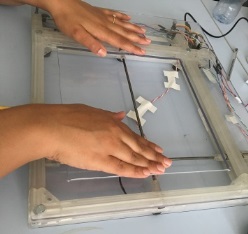Objective of the project
The "Museal guide" project aims to design, produce and validate the academic prototype of a digital device allowing access both to the museum space (independent mobility) and to the works displayed there (informative and aesthetic accessibility) in an inclusive approach (for sighted people and people with visual impairment, PVI). The Bayeux Tapestry Museum and its embroidery constitute an ecosystem to carry out the experimental work.
Context
Access to works of art in museums is limited not only for PVI, and more generally people with disabilities, but everyone (seniors and children included). No support exists to represent any work of art with an editable display. In addition, the standard indices making it possible to understand and quickly recognize a 2D object represented only in a tactile manner, are very difficult (if not impossible) to represent on conventional non-modifiable supports, because it is not possible to change the representation of the work or its scale.
Adopted Approach
The guide is a classic screen tablet on which a specific frame (with different functional buttons) and a mobile micro-joystick have been attached. On the screen a map or the image of a work of art can be displayed. A pair of glasses with a camera (for the acquisition of images of works of art) completes the guide. In addition, a set of 3D models of certain scenes from the Bayeux Tapestry will be produced (reconstruction using original approaches) with 3D printing to assist in learning the process of understanding the work of art.
Originalities
Accessibility to the museum space and aesthetic accessibility

First Prototype
The framework constitutes the interface which will allow to perceive, by exploring (in a free or guided way) with a finger on its joystick. The representation is simplified, yet interactive tactile information displayed on the screen. This tactile representation will be accompanied by an ad hoc audio description.

Unprecedented sensory stimulations
The Museal Guide makes it possible to create new aesthetic experiences, which induce unprecedented sensory stimulations and which call to mind and imagination, and to share them with others. Indeed, it is possible to make the dynamic elements perceptible to the eye in the artwork be felt tactually (for example, to appreciate the force of the wind that swells the sails of a boat, or the force of the waves of the sea). Also, the system allows the creation of new aesthetic impressions in any person, which enhances the aesthetic accessibility to the artwork, and makes it an inclusive museum guide.




